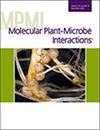求助PDF
{"title":"The Soilborne Fungus <i>Verticillium longisporum</i> and Its Interactions with the Brassicaceous Hosts.","authors":"Vahideh Rafiei, Christina Dixelius, Georgios Tzelepis","doi":"10.1094/MPMI-03-25-0029-IRW","DOIUrl":null,"url":null,"abstract":"<p><p><i>Verticillium longisporum</i>, a soilborne fungal species, is the causative agent of Verticillium stripe disease in <i>Brassica</i> species and represents a notable threat to agricultural production, particularly in regions where oilseed rape is a major crop, including Europe, North America, and Asia. The microsclerotia of this pathogen can persist in the soil for extended periods, with a potential lifespan of up to a decade, thereby posing a substantial challenge for the complete eradication of the pathogen from infested soil. The genome of <i>V. longisporum</i> is amphidiploid and resulted from the hybridization of <i>V. dahliae</i> (D genotypes) and an unidentified species (A1 genotype). At least three independent hybridization events are estimated to have occurred, resulting in three distinct lineages: A1/D1, A1/D2, and A1/D3. Genome sequence analysis revealed the presence of mating-type idiomorphs, putative cell wall-degrading enzymes, and effectors. However, due to the complexity of the genome, there is a paucity of research on the molecular interactions between <i>V. longisporum</i> and <i>Brassica</i> crops. This review summarizes the extant knowledge regarding the pathogenicity factors that <i>V. longisporum</i> deploys upon infection and the host immune responses against this attack, highlighting aspects that remain to be elucidated and the molecular tools available for studying this interaction. A better understanding of the molecular interactions in this pathosystem will contribute to developing more effective control measures against this disease in <i>Brassica</i> oilseed and cabbage crops. [Formula: see text] Copyright © 2025 The Author(s). This is an open access article distributed under the CC BY-NC-ND 4.0 International license.</p>","PeriodicalId":19009,"journal":{"name":"Molecular Plant-microbe Interactions","volume":" ","pages":"497-504"},"PeriodicalIF":3.4000,"publicationDate":"2025-07-01","publicationTypes":"Journal Article","fieldsOfStudy":null,"isOpenAccess":false,"openAccessPdf":"","citationCount":"0","resultStr":null,"platform":"Semanticscholar","paperid":null,"PeriodicalName":"Molecular Plant-microbe Interactions","FirstCategoryId":"99","ListUrlMain":"https://doi.org/10.1094/MPMI-03-25-0029-IRW","RegionNum":3,"RegionCategory":"生物学","ArticlePicture":[],"TitleCN":null,"AbstractTextCN":null,"PMCID":null,"EPubDate":"2025/7/24 0:00:00","PubModel":"Epub","JCR":"Q2","JCRName":"BIOCHEMISTRY & MOLECULAR BIOLOGY","Score":null,"Total":0}
引用次数: 0
引用
批量引用
Abstract
Verticillium longisporum , a soilborne fungal species, is the causative agent of Verticillium stripe disease in Brassica species and represents a notable threat to agricultural production, particularly in regions where oilseed rape is a major crop, including Europe, North America, and Asia. The microsclerotia of this pathogen can persist in the soil for extended periods, with a potential lifespan of up to a decade, thereby posing a substantial challenge for the complete eradication of the pathogen from infested soil. The genome of V. longisporum is amphidiploid and resulted from the hybridization of V. dahliae (D genotypes) and an unidentified species (A1 genotype). At least three independent hybridization events are estimated to have occurred, resulting in three distinct lineages: A1/D1, A1/D2, and A1/D3. Genome sequence analysis revealed the presence of mating-type idiomorphs, putative cell wall-degrading enzymes, and effectors. However, due to the complexity of the genome, there is a paucity of research on the molecular interactions between V. longisporum and Brassica crops. This review summarizes the extant knowledge regarding the pathogenicity factors that V. longisporum deploys upon infection and the host immune responses against this attack, highlighting aspects that remain to be elucidated and the molecular tools available for studying this interaction. A better understanding of the molecular interactions in this pathosystem will contribute to developing more effective control measures against this disease in Brassica oilseed and cabbage crops. [Formula: see text] Copyright © 2025 The Author(s). This is an open access article distributed under the CC BY-NC-ND 4.0 International license.

 求助内容:
求助内容: 应助结果提醒方式:
应助结果提醒方式:


